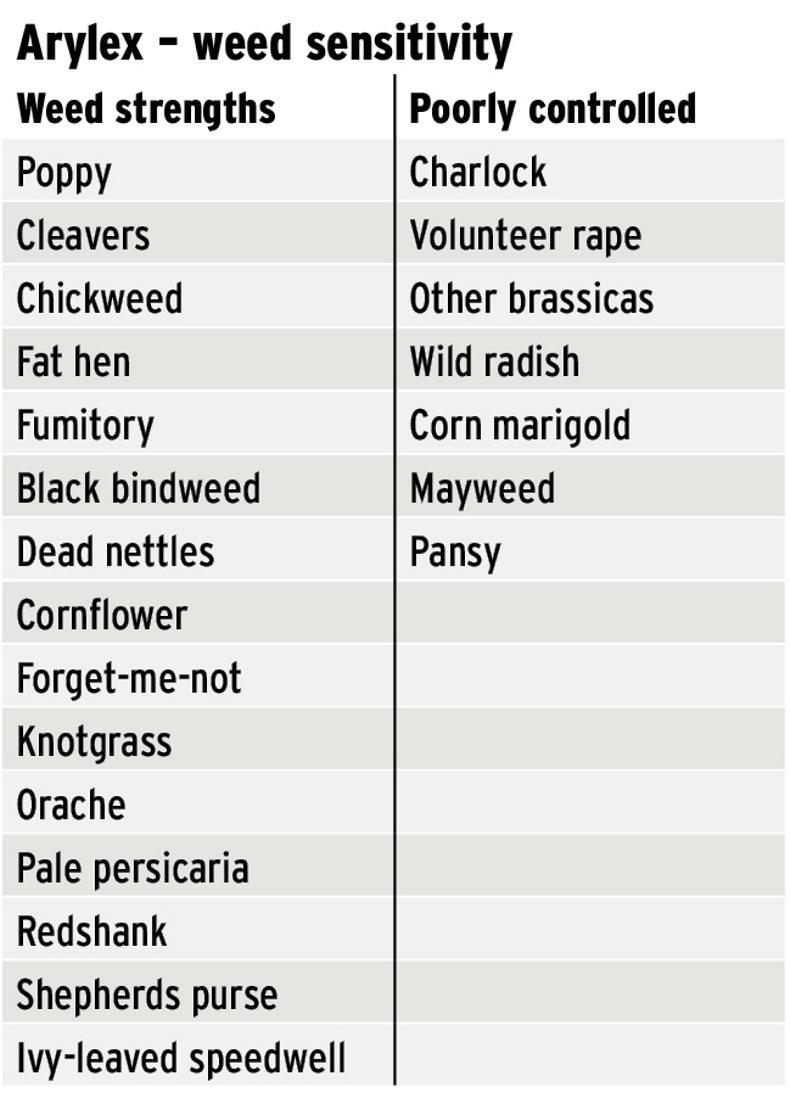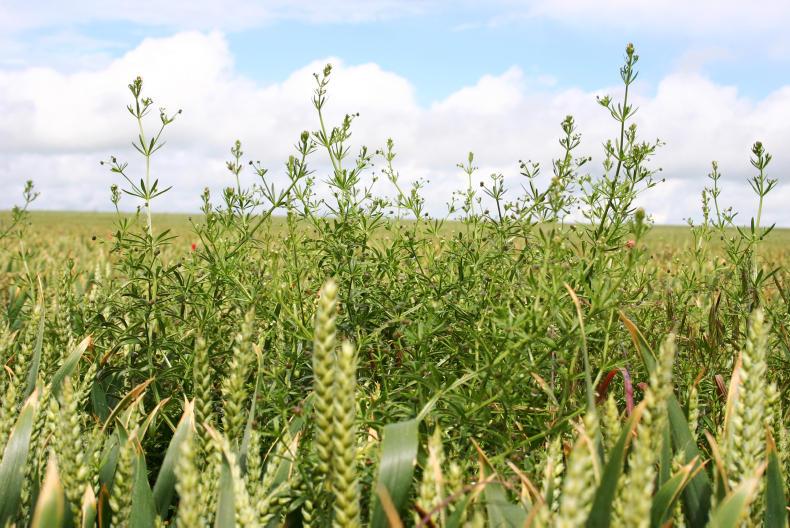The generalisation that we have more problems than solutions in tillage farming has been dealt a blow with the launch of a new herbicide active called Arylex Active. This is not just a new active but also a new family of herbicide actives with a suggested relatively low risk of resistance development.
The PCS number for a new commercial herbicide from Dow AgroSciences called Pixxaro is 05525. And for Northern growers this number is MAPP 17545. Pixxaro contains a mix of fluroxypyr (280 g/l) plus halauxifen-methyl (12 g/l). Halauxifen-methyl is the actual active that is being referred to as Arylex Active trademark.
Arylex is a brand new class of chemistry known as an Arylpicolinate, a member of the synthetic auxin group. Halauxifen-methyl itself is very active against a big range of weeds, many of which have now developed resistance to the ALS or sulfonylurea herbicides. This makes it particularly useful and interesting at this point.
It is also planned to bring Arylex to market in a combination with florasulam, to be called Zypar.
Flexibility in use
One of its main stated features is its flexibility across a wide range of weather conditions at the time of spraying. This is a rare but not exclusive characteristic that enables growers to spray when they get the opportunity rather than having to wait until the weather is right.
However, timing cannot be ignored because Arylex is not to be sold as a stand-alone active and it is accompanied by fluroxypyr, which is temperature-sensitive, in Pixxaro. The window of application is very wide, with application cleared up to GS45 or halfway through booting. Earliest spraying dates are 1 February for winter cereals and 1 March for spring cereals with a maximum rate of 0.5 l/ha. It is sold in a 5.0l pack and formulated as an emulsifiable concentrate (EC).
Listen to an interview with Stuart Jackson, cereal technical specialist for herbicides at Dow, in our podcast below:
Listen to "New herbicide active from Dow" on Spreaker.
Dow AgroSciences states its new Arylex active provides great flexibility within tillage systems. It offers considerable flexibility with regard to spraying conditions and it also is very flexible with regard to following crop options. It provides no restrictions for straw or manure use, and management and cultivation is not required following its use ahead of planting many other crops. On top of these benefits, it is hugely flexible in tank mixes.
Its only constraint is that it needs to be applied with a non-ionic wetter or a methylated seed oil.
Pixxaro is strong on a wide range of weeds across a wide range of growth stages. And the fact that there are no major following crop restrictions outlines its suitability for use in rotational systems.
Big weed spectrum
 Pixxaro is active on a wide range of weeds and Arylex itself carries a broad range of activity. Among the major weeds on the label are poppy, cleavers, chickweed, fat hen, fumitory, black bindweed, dead nettle, hemp nettle etc. But many others are also controlled at full rate and these include cornflower, small docks, forget-me-not, henbit dead nettle, knotgrass, orache, pale persicaria, redshank, shepherds purse, ivy-leaved speedwell etc.
Pixxaro is active on a wide range of weeds and Arylex itself carries a broad range of activity. Among the major weeds on the label are poppy, cleavers, chickweed, fat hen, fumitory, black bindweed, dead nettle, hemp nettle etc. But many others are also controlled at full rate and these include cornflower, small docks, forget-me-not, henbit dead nettle, knotgrass, orache, pale persicaria, redshank, shepherds purse, ivy-leaved speedwell etc.
Notable exceptions from the control spectrum are the brassicas. Weeds such as charlock, volunteer rape and wild radish are acknowledged as tolerant to Pixxaro, as are corn marigold, mayweed and pansy. So while it will get a number of the ALS resistant species, it will not control them all. But for some aggressive weeds such as cleavers, both actives offer good control and the manufacturer suggests that Arylex is even better than fluroxypyr. Arylex is also very strong on its own against fumitory.
As with the other auxins, one of the key characteristics of Arylex application is the rapid onset of twisting symptoms in susceptible plants. Knockdown and symptoms occur rapidly and many weeds can be dying within six days of application.
Pixxaro can be used on all cereals, winter and spring, except oats, from springtime up to GS45. However, it is anticipated that oats will soon be added to the list of recommended crops.
Mode of action
Arylex itself is a contact systemic herbicide which is primarily absorbed by the foliage, so it has no residual activity. Once it enters the weed cells it is metabolised into an active form and then translocated via the vascular system to accumulate in the meristematic tissue or growing points. Here it acts on the growing points to cause distortion or twisting of the plant structures. Hence these symptoms are quickly seen in the field.
Selectivity in the crops is a result of rapid metabolism to degrade the active in non-target or non-affected plants. Even in poor growing conditions, the active remains stable within the target plant and the various processes then occur once the plant begins to grow. When this happens, symptoms of activity become very visible.
Arylex is taken into the plant as the methylester (the formulation used) and once it is in the plant, de-esterification takes place. This means that the herbicide is converted into the active acid form and is translocated within the plant’s vascular system to the growing points where it is active. This process happens in target and non-target plants.
As with any chemical, once it enters the plant it begins to be metabolised by the plant cells and will be broken down in time. Different plant species have different ability to metabolise the herbicide – some do it very quickly while other species do it very slowly. It is this differential metabolism rate that is the basis of plant selectivity or control.
In general, the rate of metabolism is faster in monocots (grass-type species) than in the more sensitive dicots and hence the product tends to be more selective towards the dicots. But some dicot species do break it down more rapidly than others and this is the basis for weed control and selectivity.
I am informed that the rate of initial de-esterification is also slower in cereals than in dicots and this slows down the production and translocation of the active.
Specific site of action
With resistance now such a concern in modern agriculture, it is good to know that this new Arylex active appears to be both unique and robust. Synthetic auxin herbicides have long played an important role in weed control. Research has shown that auxin herbicides bind to receptors in plant cells to alter their growth and thereby enable weed control in susceptible species.
Recent research has shown that the new arylpicolinates prioritise a different target site to natural auxin and other auxin herbicides. This also showed that they bind to their specific target site with high affinity.






SHARING OPTIONS